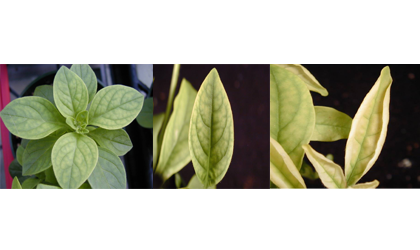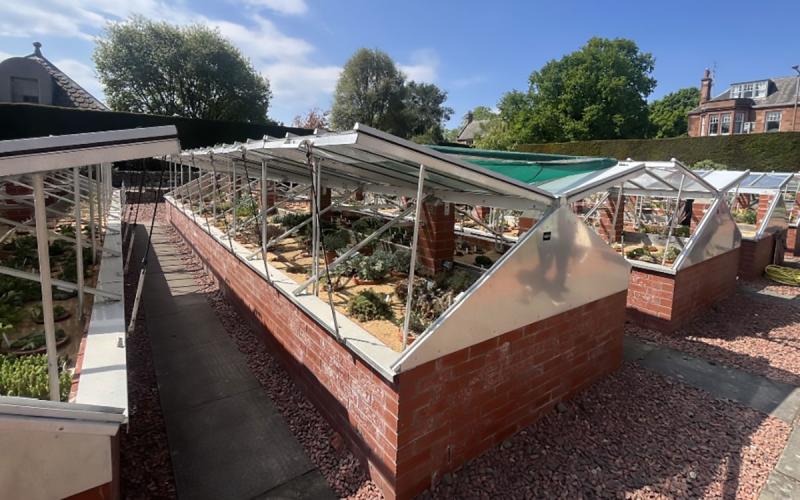Article by Geoffrey Njue, former SDSU Extension Specialty Crops Field Specialist.
At this time in the growing season, Iron (Fe) deficiency symptoms are appearing among bedding plants and other spring greenhouse plants. The main symptom of Iron (Fe) deficiency is Chlorosis or yellowing, usually starting at the shoot tip and newly developed leaves. The yellowing or chlorosis may appear only between the veins (interveinal Chlorosis) or the entire leaf may be chlorotic. As the problem gets worse the color of the chlorosis may change from yellow to white. In severe cases the growing tips may die and are replaced by many growing tips that also turn white. Iron deficiency causes plants to be unsalable.
Different stages of iron deficiency symptoms on petunia
Iron (Fe) deficiency Symptoms are caused by high pH of the growing medium which decreases the solubility of micronutrients especially Iron (Fe) and Manganese (Mn) in the soil solution. Certain plant species, such as petunia, calibrachoa, vinca, nemesia, diascia, bacopa, dianthus, pansies, verbena, snapdragons and azalea are inefficient in taking up Iron (Fe) from the soil solution. The inefficient plants are sensitive to high pH because they lack the physiological mechanism to overcome Iron (Fe) deficiency by increasing uptake.
There are three practices growers can use to prevent (Fe) deficiency on Iron (Fe) inefficient plants:
- Monitoring and maintaining control of growing medium pH. Iron inefficient crops have a low target pH range of 5.5-6.2. Use of acid forming fertilizers that have higher percentage of ammoniacal nitrogen will be enough to keep the pH of the growing medium in this range. However if the irrigation water is alkaline then acid injection into the irrigation water might be needed.
- Low Phosphorus (P) fertilization. In certain circumstances Phosphorus (P) and Iron (Fe) can react with each other to form insoluble Iron Phosphates. The Iron in the Phosphates is not available to the plants. Growers should therefore not mix superphosphates in the growing medium, and should not use phosphoric acid injection into the irrigation water for Iron inefficient plants. Growers should also use low Phosphorus (less than 10%) water soluble fertilizers when growing Iron inefficient crops.
- Fertilize Iron inefficient crops with iron. Fertilizing from time to time with Iron Chelate (e.g Sprint 330) is a proactive way of preventing Iron (Fe) deficiency. The Chelates are applied as soil drench and can be applied every 3-4 weeks if desired. It is important to rinse excess iron off the foliage and flowers because this can cause brown spots.
For more information on how to prevent nutrient deficiency in greenhouse crops, please access the UNH Greenhouse and Floriculture publication “Scouting and Managing Greenhouse Nutrient Problems".



